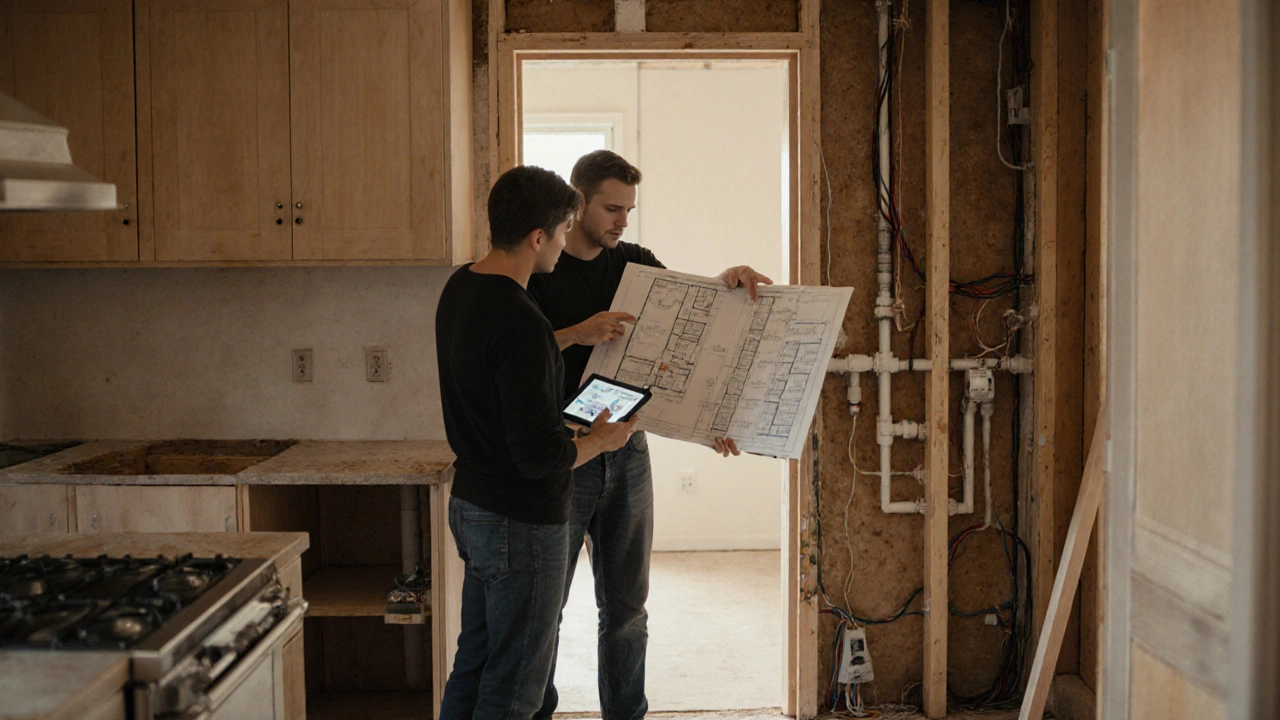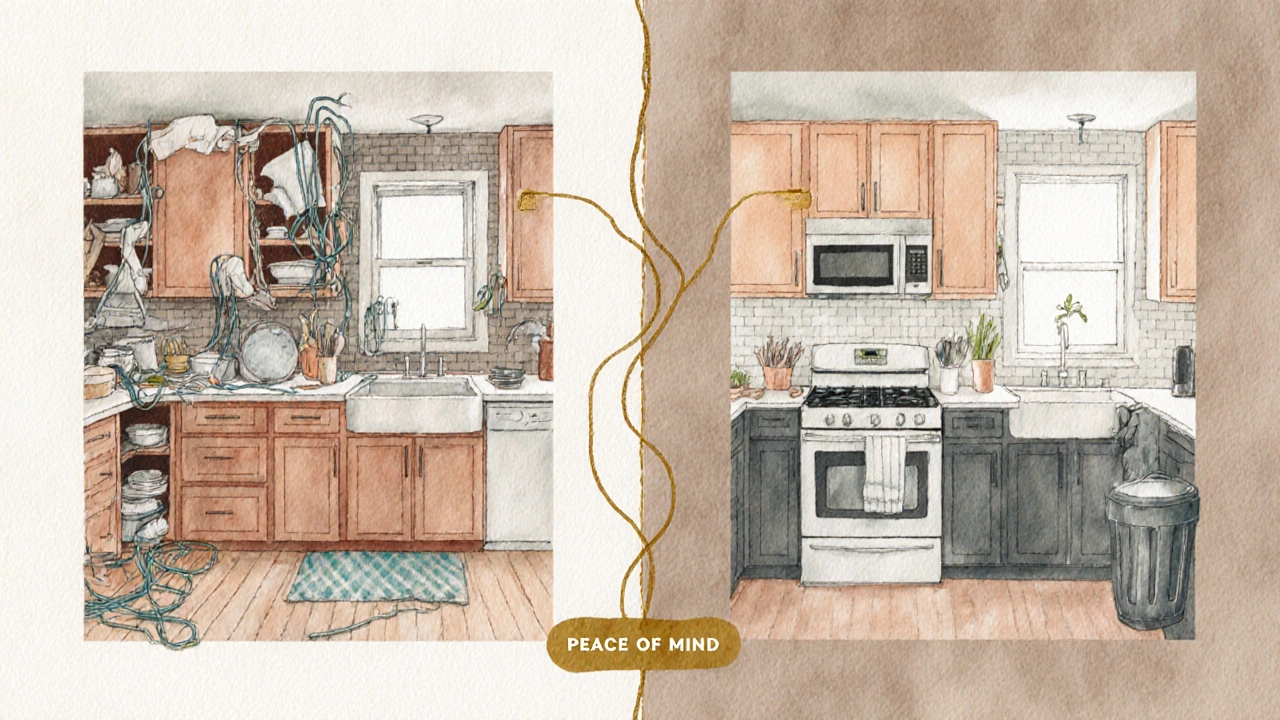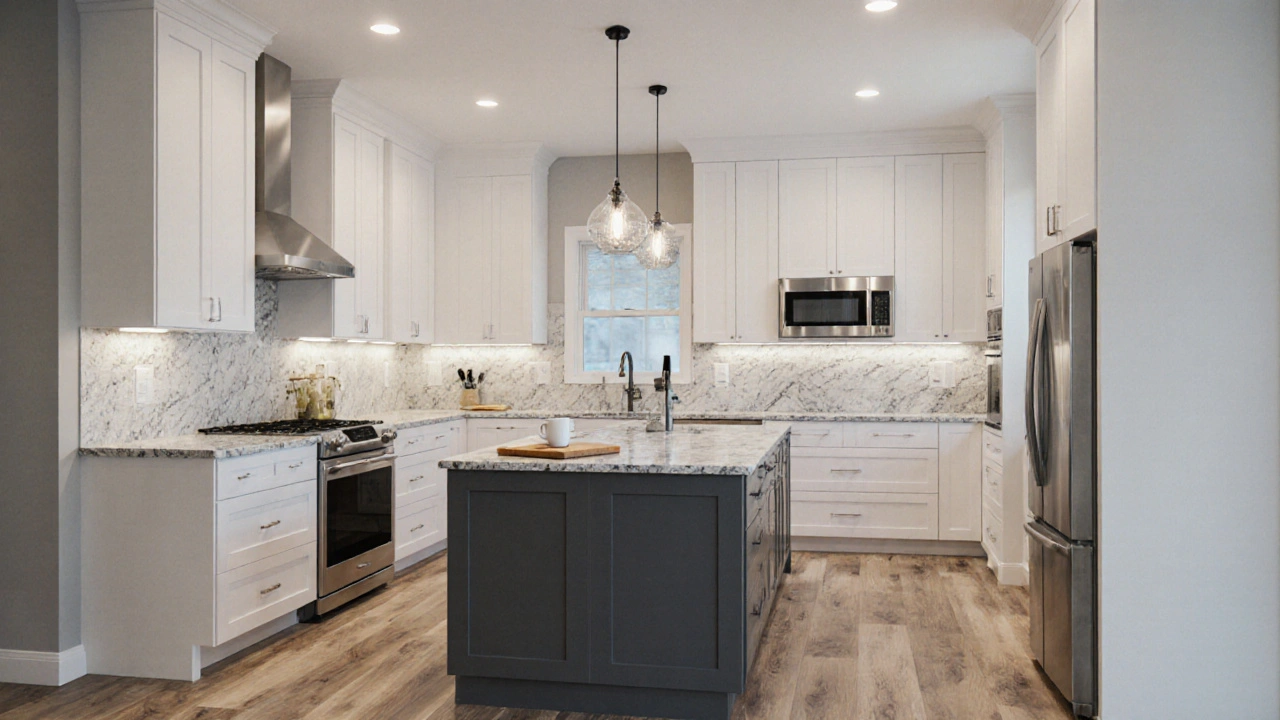You’ve got the vision: sleek cabinets, a massive island, quartz countertops that gleam under LED strips. But then comes the question: Do I need an interior designer for a kitchen remodel? The answer isn’t yes or no-it’s what kind of remodel you’re planning.
When You Can Skip the Designer
If you’re doing a straightforward swap-keeping the same layout, replacing cabinets with similar ones, upgrading appliances, and sticking to stock finishes-you probably don’t need a pro. A good contractor can handle the build, and you can pick out materials from Home Depot or IKEA. Many homeowners do this successfully every year. In fact, a 2024 survey by the National Kitchen & Bath Association found that 62% of homeowners who did minor to moderate kitchen updates didn’t hire a designer. They used Pinterest boards, YouTube tutorials, and a lot of patience.But here’s the catch: those same homeowners reported spending 30% more time on decisions than they expected. Choosing between 17 shades of white quartz? Figuring out if your 36-inch range hood will clear the ceiling? Deciding where to put the trash pull-out? It adds up.
When You Absolutely Need One
If your remodel involves moving walls, shifting plumbing or electrical lines, or reconfiguring the kitchen triangle (the triangle formed by your sink, stove, and fridge), you’re in complex territory. That’s where an interior designer-or better yet, a kitchen-specific design professional-becomes essential.Most contractors aren’t trained in spatial optimization. They’ll build what you ask for, but they won’t tell you that putting the dishwasher next to the fridge creates a cold air draft that makes it less efficient. Or that your 42-inch upper cabinets block the window light you wanted for morning coffee.
A good kitchen designer knows the rules of ergonomics: how high your countertops should be for your height, how much clearance you need between the island and the walkway (minimum 42 inches, but 48 is ideal), and where to place outlets so you’re not tripping over cords while plugging in your air fryer. They’ve seen what happens when people don’t plan for charging stations, hidden trash bins, or kid-friendly storage.
What a Designer Actually Does
People think designers just pick colors and curtains. That’s not it. A kitchen designer does five key things:- Plans the layout based on how you cook, not what looks pretty in a magazine.
- Manages the flow so your kitchen works with the rest of your home-no awkward door swings, no dead-end corners.
- Selects materials that actually hold up: non-porous quartz for high-use counters, stain-resistant backsplashes, cabinets with soft-close hinges that last 15+ years.
- Coordinates with trades so the electrician, plumber, and cabinet installer don’t step on each other’s toes.
- Handles the timeline so you’re not stuck without a kitchen for six months because the sink arrived late.
They also have access to trade-only suppliers. You won’t find the same custom cabinetry, specialty lighting, or high-end hardware at big-box stores. One client in Burlington saved $8,000 on cabinetry because their designer had a direct line to a local maker who cut out the middleman.

The Cost Question
Designers charge anywhere from $75 to $250 an hour, or 10% to 20% of your total remodel budget. That sounds steep-until you realize what you’re paying for: avoiding mistakes that cost $5,000 to fix later.Think about it: you buy a countertop that doesn’t match your cabinets because you didn’t see the samples under natural light. You install lighting that casts shadows on your prep area. You end up with a sink that’s too shallow, so water splashes everywhere. These aren’t hypotheticals. I’ve seen them all.
One homeowner in Oakville spent $42,000 on a remodel and realized after the fact that their island was too close to the door. Every time someone walked in, they bumped into the barstools. Fixing it meant tearing out the island and rebuilding it. Cost: $9,000. Designer fee? $3,500.
Alternatives to Full-Service Designers
You don’t have to hire someone full-time. There are middle-ground options:- Design consultations: Pay $150-$300 for a 2-hour session. Bring your floor plan, and they’ll give you a layout sketch and material suggestions.
- Online design services: Companies like Havenly or Modsy let you upload photos and get a full plan delivered digitally for $199-$499. They include 3D renderings and shopping lists.
- Architects with kitchen focus: If you’re doing structural changes, an architect can handle both the build and the design. They’re pricier but cover more ground.
These options work well if you’re hands-on and just need someone to catch the stuff you’d miss. But if you’re overwhelmed by choices, hate decision fatigue, or just want to sleep at night knowing your kitchen won’t be a nightmare in six months, full-service is worth it.

What to Look for in a Kitchen Designer
Not all designers are created equal. Here’s what to ask:- Do you specialize in kitchens? (General interior designers often lack kitchen-specific knowledge.)
- Can I see your portfolio of actual completed kitchens-not just renderings?
- Do you work with local contractors and suppliers?
- What’s your process for handling changes during the build?
- Can you provide references from past clients?
Ask for a contract that includes a detailed scope: how many revisions are included, what deliverables you’ll get (floor plans, elevations, material boards), and whether they manage the timeline. Avoid anyone who asks for 50% upfront before any work starts.
Real Talk: Who Benefits Most?
You’re most likely to benefit from a designer if:- You’re remodeling for resale-designers know what buyers want (and what turns them off).
- You cook often and need a functional space, not just a pretty one.
- You have a small or oddly shaped kitchen and need every inch optimized.
- You’re juggling work, kids, and life and don’t have time to research every hinge, faucet, and backsplash.
- You’ve been burned before by a DIY project that went sideways.
If you’re young, budget-conscious, and willing to spend weekends on Pinterest and Home Depot, you can do it yourself. But if you want a kitchen that works as well as it looks-and doesn’t become a source of stress-you’re better off hiring someone who’s done this 50 times before.
Final Thought: It’s Not About Luxury, It’s About Confidence
You don’t need a designer because you want marble countertops or gold faucets. You need one because you want to know, without a doubt, that your kitchen will be functional, safe, and beautiful for the next 15 years. That peace of mind? That’s worth more than the fee.Can I just use my contractor’s design services instead of hiring a designer?
Some contractors offer design as part of their package, but most are builders, not designers. They’ll follow your instructions, but they won’t challenge your ideas or spot inefficiencies. A professional designer brings objectivity and expertise you won’t get from someone whose main goal is to finish the job on time. If your contractor doesn’t have a dedicated design team, it’s safer to hire an independent designer.
How much should I budget for a kitchen designer?
Design fees typically range from 10% to 20% of your total remodel budget. For a $50,000 kitchen, that’s $5,000-$10,000. Some designers charge hourly ($75-$250/hour), while others offer flat-rate packages. Always get a written scope of work before paying anything. Avoid anyone who asks for more than 30% upfront.
Do I need a designer if I’m doing a kitchen update, not a full remodel?
For a simple update-new paint, hardware, lighting, or backsplash-you probably don’t need one. But if you’re changing cabinet layouts, adding an island, or reconfiguring the sink and stove, even a small change can throw off your workflow. A one-hour consultation ($200) can save you from costly mistakes.
Can a designer help me stay within budget?
Yes. Good designers know how to prioritize spending. They’ll steer you away from expensive trends that won’t last and toward smart investments like durable countertops and quality cabinetry. They also have access to trade discounts and can help you avoid impulse buys that blow your budget.
How long does it take to work with a kitchen designer?
The design phase usually takes 4-8 weeks, depending on complexity. After that, the build can take another 8-12 weeks. Don’t rush the design phase-it’s where most problems are prevented. If a designer promises a full plan in two weeks, they’re likely cutting corners.





Yashwanth Gouravajjula
November 7, 2025 AT 21:28In India, we do kitchens without designers all the time. Grandmas know where to put the stove, where the water goes, and how to avoid clutter. No Pinterest needed. Just experience.
Kevin Hagerty
November 9, 2025 AT 21:06Oh wow a 2000 word essay on why you should pay someone to tell you not to put the fridge next to the oven. Wow. I’m crying. Next up: ‘Do You Really Need a Brain to Avoid Walking Into Walls?’
Janiss McCamish
November 11, 2025 AT 01:50My cousin spent $12k on a remodel and forgot to leave space for the microwave. She had to buy a new one that fit the tiny gap. A $200 consultation would’ve saved her. Don’t be her.
Richard H
November 11, 2025 AT 07:52Designers? That’s what you get when you let foreigners tell you how to build your own house. We used to build kitchens with hammers and guts. Now we pay people to tell us where to put a sink? This is why America’s falling apart.
Kendall Storey
November 13, 2025 AT 04:29Look, if you’re doing a full gut job with structural changes, skip the DIY route. A good designer isn’t a luxury-they’re your project’s QA lead. They catch the stuff that’ll turn your dream kitchen into a 6-month nightmare. Trade discounts? Timeline management? Yeah, that’s the real ROI.
Ashton Strong
November 13, 2025 AT 21:49It is with profound respect for the diligence of the modern homeowner that I offer this observation: the decision to engage a professional kitchen designer is not one of extravagance, but of prudence. The emotional and financial toll of suboptimal spatial planning is both measurable and deeply regrettable.
Steven Hanton
November 14, 2025 AT 09:49I appreciate how the post breaks down the real value of designers-not just aesthetics, but workflow and longevity. I tried doing my own layout once and ended up with a 38-inch clearance instead of 42. It’s tight. Not deadly, but annoying every single day. Worth the consultation.
Pamela Tanner
November 15, 2025 AT 12:46One thing missing from this article: the importance of lighting layers. Can’t stress this enough. Overhead lights alone create shadows. Add under-cabinet LEDs and task lighting near the sink. It’s not optional-it’s ergonomic.
Kristina Kalolo
November 16, 2025 AT 11:26My friend hired a designer for a $30k remodel. They saved her $7k by switching to a local cabinet maker and repositioning the dishwasher to avoid a vent conflict. She said it was the best $2k she ever spent.
ravi kumar
November 17, 2025 AT 15:42I did my own kitchen in Bangalore. Used local carpenter, bought materials from local market. Took 3 months. No designer. But I watched 47 YouTube videos and drew everything on paper. Worked fine. Just need patience.
Megan Blakeman
November 18, 2025 AT 09:57Okay, but what if you’re not rich? I love the idea of a designer… but $5k? That’s my rent for 3 months. I get that they help, but… can’t we just… be smarter? Maybe a 1-hour Zoom call with someone who’s done 100 kitchens? That’s all I need. 😅